One of the common things a lot of preppers miss is a good SHTF first aid kit.
Sadly, they don’t even realize it. That’s because most people have a $9.99 first-aid kit they picked up at the local pharmacy or department store or from Amazon and so think they’re covered. But that’s not enough to prepare you for emergencies by any means. That’s about enough to take care of cut fingers and skinned knees, that’s it.
Unless you’ve made your own SHTF first aid kit or bought a good trauma kit, you probably don’t have anywhere near what you need. That might even be true if you have a good trauma kit. You see, for survival purposes, a SHTF first aid kit has to have extensive breadth and depth, and most commercially available kits don’t have both.
What do I mean by breadth and depth?
Breadth means being able to take care of a wide number of different injuries, including serious injuries (trauma). A good trauma kit will have that, but the local pharmacy version won’t. Depth means that you can take care of several of those serious injuries with the supplies that are included in that first aid kit. Even the best trauma kits have trouble in this, unless you actually buy one that’s intended for use by a paramedic or EMT.
During a time of crisis, medical facilities tend to get overcrowded making them almost impossible to function. Just take a look at how hospitals looked during Huricane Katrina. On top of that, there can be a problem in even getting to your local hospital or clinic. So, having that well-stocked SHTF first aid kit can very well be a lifesaver for someone in your family.
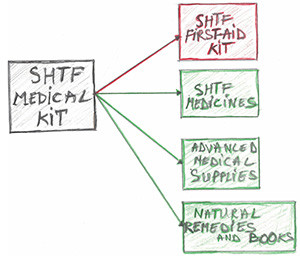
Please note that first-aid is just that.
A SHTF first aid kit is not a complete medical kit (as seen in the graphic). All you are doing with first-aid is keeping things from getting worse or deadly. That’s good, in and of itself, but it may not be enough.
This article is about building the SHTF first aid kit. If your interesting in “SHTF Medicines” you may want to read this article.
“Advanced Medical Supplies” are for doctors or people trained to use them. For example a good medical supply would be adrenaline. But used by an untrained person, instead of helping someone may even cause his death.
If you’re interested in “Natural Remedies and Books” you may want to read one the appropriate books here or simply download my book with all 68 plants that will substitute drugs when there won’t be any.
The Kit Itself
To start with, you need something to use to put all this stuff in. It needs to be something that you can organize the contents in well, so a case with lots of dividers or small compartments in it is ideal. Many trauma kits come in a soft-case, which is easier to take along with you. But it’s hard to find a case like this that’s large enough. I have a first-aid kit I built in a roll-up shaving kit, which I keep in my car. But that’s not big enough for my main SHTF first aid kit.
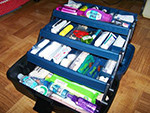 My main kit is in a large fishing tackle box. The cantilevered trays provide a great place to organize the small items and the open bottom of the box gives me a good place for the larger stuff. This makes for an easy to grab kit, which I can take where it’s needed. It’s also very easy to work with, mostly because the case makes it easy to organize everything.
My main kit is in a large fishing tackle box. The cantilevered trays provide a great place to organize the small items and the open bottom of the box gives me a good place for the larger stuff. This makes for an easy to grab kit, which I can take where it’s needed. It’s also very easy to work with, mostly because the case makes it easy to organize everything.
The Contents
I highly recommend going with quality medical supplies and only quality medical supplies. This is another problem I find with most commercial first-aid kits. Rather than using the highest quality supplies they can, they use the cheapest. This makes a difference, like when it comes to keeping a bandage in place. If it’s not quality, chances are, it will come off when you don’t want it to.
Hygiene
Most wounds don’t kill directly. About the only way a wound can kill directly is if a major organ is damaged. Typically, they kill by allowing the patient to bleed out or by infection. Bandaging is supposed to stop the bleeding, but if the wound isn’t kept clean, the patient can still die of an infection.
For this reason, it’s extremely important to keep the wound and the surrounding area clean. That also means keeping yourself from introducing any bacteria into the wound. So, you’ve got to clean up your own act, before treating the patient. This also helps protect you from any infectious diseases they might have.
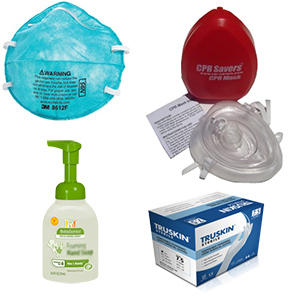 Anti-bacterial hand cleaner – Always wash up before treating a wound
Anti-bacterial hand cleaner – Always wash up before treating a wound- Sterile rubber gloves – Make sure they are the sterile type and not just rubber gloves
- Medical face mask – So that you don’t breathe any germs onto the wound
- CPR mask – If you need to provide CPR, this protects both you and the patient from infections (in the right upper corner of the picture)
Estimated total cost: $200
Flesh Wounds
The majority of what a SHTF first aid kit is designed to deal with is flesh wounds. This means anything from a paper cut to a severed limb. In all cases, your purpose in providing first-aid is to stop the bleeding and protect the wound. Depending on the size of the wound, this can require many different things.
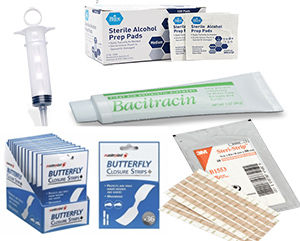 Irrigation syringe – Before bandaging the wound, it needs to be cleaned out. This is done by squirting clean water into it. If the water is clean enough to drink, it’s clean enough for irrigation
Irrigation syringe – Before bandaging the wound, it needs to be cleaned out. This is done by squirting clean water into it. If the water is clean enough to drink, it’s clean enough for irrigation- Alcohol towelettes – For cleaning the wound and the area around it. Have a goodly supply, because they are rather small
- Antibacterial ointment – Put on the wound to kill bacteria that can cause infections
- Butterfly closures or Steri-strips – Both are used to close wounds where the skin is open or separated. This will help protect the wound, reduce bleeding and encourage healing
Related: Best Natural Firs Aid: Stops Bleeding in 10 Seconds!
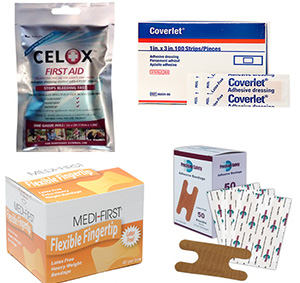 Clotting agent – There are several brands of these available, such as Celox or QuikClot. They are designed to help speed up the clotting process. Available as crystals to sprinkle on the wound or imbedded in a bandage
Clotting agent – There are several brands of these available, such as Celox or QuikClot. They are designed to help speed up the clotting process. Available as crystals to sprinkle on the wound or imbedded in a bandage- Cloth adhesive bandage strips – The cloth type are flexible, so they won’t pop off when the patient move
- Cloth knuckle bandages – One of the hardest things to bandage is a knuckle, because of the movement. This specialty bandage will keep scraped knuckles clean, moving with the finger
- Cloth fingertip bandages – Another specialty bandage for a hard-to-bandage area
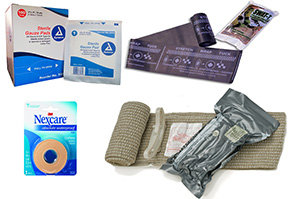 Large bandages – Stock some 4″x 6″ and 2″x 3″ sterile gauze pads for dealing with medium sized wounds. These will not have adhesive on them. If you don’t have these, and if it’s an emergency, you can substitute them with sanitary napkins.
Large bandages – Stock some 4″x 6″ and 2″x 3″ sterile gauze pads for dealing with medium sized wounds. These will not have adhesive on them. If you don’t have these, and if it’s an emergency, you can substitute them with sanitary napkins.- Medical tape – For use in holding those bandages in place. The newer “cohesive tape” works much better, sticking to itself, rather than to the patient’s skin. No pain of pulled out hairs when removing the tape. You definitely need some of these in your SHTF first aid kit.
- SWAT Tourniquet – Useful as a tourniquet, but also as a pressure dressing when only tightened half-way. Pressure on the wound reduces the bleeding
- Israeli bandage – The Israeli bandage is a combat bandage designed for use in the Israeli military. It combines a clotting agent with a bandage and a wrap to hold the bandage in place. Used properly, it is also a pressure bandage to reduce bleeding. These are available in 4″ and 6″ sizes. One of the easiest ways to treat a serious wound
Estimated cost: $225
As you can see, there is a lot here. That’s partially because of needing different sizes of bandages for different types of wounds. But at the same time, you can literally use half the items listed here for one wound, if it is a serious one.
Broken Bones
Broken bones fall into two general categories: fractures and compound fractures.
A compound fracture is when the end of the bone sticks out through the skin. In such cases, the fracture needs to be treated and the open wound needs to be treated. A simple fracture eliminates the need to treat the open wound, leaving only the broken bone to treat.
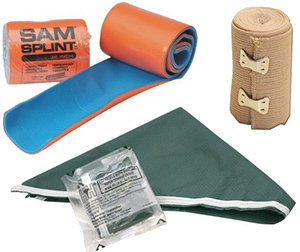 Sam splint – While just about anything can be used for making a splint, a Sam splint is much easier. This is a sheet of soft aluminum, covered with about 1/4″ of foam rubber. You can cut it with medical scissors and form it with your hands. This makes it easy to make a splint that will protect pretty much any break
Sam splint – While just about anything can be used for making a splint, a Sam splint is much easier. This is a sheet of soft aluminum, covered with about 1/4″ of foam rubber. You can cut it with medical scissors and form it with your hands. This makes it easy to make a splint that will protect pretty much any break- Elastic bandages – Commonly referred to as “Ace bandages,” you will need these to hold the Sam splint in place. They are also useful for dealing with sprains and damaged ligaments
- Combat cravat – Referred to as a bandage, it’s really just a big triangular piece of fabric, normally olive drab in color. Ideal for use as a sling for broken arms
Estimated cost: $45
Medical Tools to Have in Your SHTF First Aid Kit
You’re going to need a few tools to work with, both for treating trauma and for simple diagnosis of disease. While you and I aren’t trained medical personnel, a few tools can make a lot of difference.
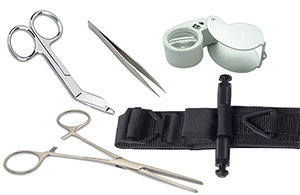 Medical scissors – For cutting off old bandages, as well as cutting off clothing to get to wounds. You want a good pair, so that you can cut through the seams of a pair of blue jeans with them
Medical scissors – For cutting off old bandages, as well as cutting off clothing to get to wounds. You want a good pair, so that you can cut through the seams of a pair of blue jeans with them- Fine-pointed tweezers – Useful for removing pieces of gravel from wounds and splinters from fingers
- Jeweler’s loupe – A magnifying glass that is held in place by the eye socket. Great when you’re trying to find those little splinters or cactus thorns to remove with the tweezers
- Hemostats – In the case of a severed limb, hemostats allow you to close off veins that are pumping blood
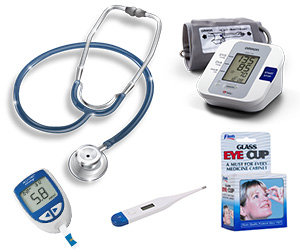 Tourniquet – Buy the one-handed kind, so you can use it on yourself, if needed. The idea is not to cut off all blood flow, but to slow it down until clotting occurs
Tourniquet – Buy the one-handed kind, so you can use it on yourself, if needed. The idea is not to cut off all blood flow, but to slow it down until clotting occurs- Stethoscope – For checking heartbeat (not an absolute requirement)
- Blood pressure monitor – Dropping blood pressure is a sign of internal bleeding. If the patient is acting faint, check their blood pressure
- Blood sugar monitor – Low blood sugar can cause people to lose strength, coordination, become shaky and not think clearly. If someone is acting like they are faint, this is a common thing to check
- Thermometer – For checking the patient’s temperature. Infections, whether systematic or from a wound, will cause an increase in temperature. The in-ear type of thermometers are best
- Eye cup – Used with sterile water or saline, the eye cup is for cleaning debris out of the eye
Estimated cost: $300
Other Things to Put in Your SHTF Emergency Kit
There are many different things that you may want to consider adding to your SHTF first aid kit, such as over the counter medicines. It’s not my purpose to discuss those here, but take a look at the things you use regularly and make sure you have a good stock of them.
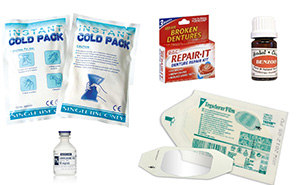 Instant cold packs – Applied to a sprain or other non-bleeding injury, these can reduce swelling; but they must be applied quickly, as they only have an effect in the first 15 minutes
Instant cold packs – Applied to a sprain or other non-bleeding injury, these can reduce swelling; but they must be applied quickly, as they only have an effect in the first 15 minutes- Dental repair paste – While not technically a trauma item, a chipped tooth or a cavity can cause a lot of pain. Filling it temporarily with this paste can relieve the pain and make it possible to function for a few days
- Tagaderm – A transparent film dressing, ideal for use over rashes and burns to hold in the medical cream that you apply to the irritated skin
- Benzoine – You can get by without this most times, but benzoine is used to clean the area around a wound, so that the adhesive on the bandage will stick
- Lidocane – A local antiseptic which can be injected or applied topically to reduce pain in a wound. May be necessary, in order to get the patient to allow you to touch the wound
- Anti-inflammatory medicines – I’m sure there are over 25 brands to choose from. But because we are talking about an SHTF first aid kit, I’m thinking that you might want to add something with at least medium effects like Diclotard.
Estimated cost: $160
I realize this makes a rather extensive list, but really it’s just the basics. Things that can be used without medical experience. Otherwise the list would have included a lot of things like Hydrocortisone, Chlorphenamine, Antihistamins. Adrenalina and a lot more!
At a time when you can’t just call for an ambulance, there’s a good chance that you’ll need every item on this list. While I hope that isn’t so, I’d rather see you prepared.
You may also like:
 9 Unusual Things You’ll Find Inside an Army Medic’s First Aid Kit
9 Unusual Things You’ll Find Inside an Army Medic’s First Aid Kit
This Bug Will Kill Most Americans During The Next Crisis (video)

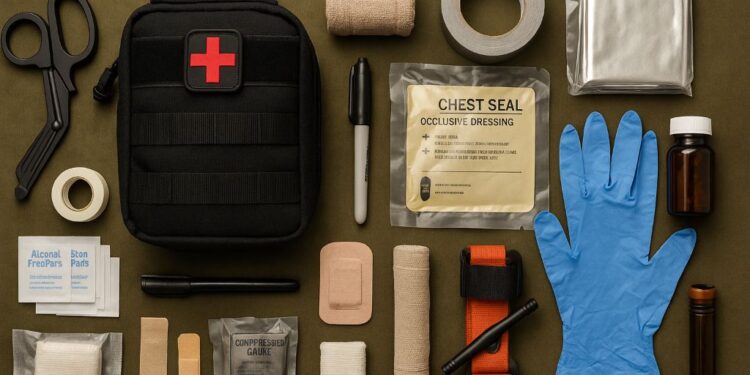




















You can substitute bottled isopropyl alcohol on 2×3 gauze pads in lieu of alcohol wipes. IPA comes in 3 strengths at the local pharmacy, 30%, 60% and 90%. You need at least 60% in order to kill bacteria. 30% is just for use as a fever reducing wipe. You might have to look harder for 90% but some drug stores carry it. Quik Clot has to be cleaned out of the wound once the bleeding has stopped. The instructions say to have the task performed at the hospital. If trained medical help is not available you will have to do it. Instructions are not included with Quik Clot on how to clean it out of the wound. I suppose irrigation with sterile water would do. A really good book is “Survival Medicine by Dr. Ryan Chamberlin. It talks about how to actually do simple medical procedures. It doesn’t end every instruction with “Seek Prompt Medical Attention.” The book pre-supposes that “Prompt Medical Attention” just is not going to be available. Short of medical textbooks, I think it is the best really practical field medicine book I have found. It is in my SHTF medical kit as my go to reference book.
Hi left Coast Chuck, up in our area I have only been able to stock on the 50%,70%, & 90% It seems our small town carrieds the 50% more then any of them. Do you think that will be alright of the smaller wounds and 70% for more? I have been going over 50yrs that way so far and I have had some cuts and bruises and blisters. Clearing my land without machinery and building as a woman it is easy to have ouches. lol…
Betadine not Benzoine
Betadine is used for cleaning wounds, benzoine is used to make adhesive (butterfly closures) adhere better. I would recommend against electronic BP monitor. Get a real cuff and learn how to use it.
Where do you get the injectable lidocane from, for like numbing are to stitch someone up? Is is a prescription med only?
Mountain side medical. Com Can be ordered and shipped to your door
Any gloves that come in a multi-Use box are not sterile. Only gloves packaged in pairs in a plastic package with sterile paper inside are sterile. And unless you know how to don them properly they are no different than clean gloves. (Not that it’s hard to learn but they are very expensive.)
Sterile gloves are only used for surgery, sterile procedures and very extensive already clean wounds.
Regular gloves are best taken out of the box and packaged in small ziptop bags in pairs to prevent the rest of the box from being contaminated. If you pack them by laying two together, folding them in half and tightly rolling them, you should get most if not all back in the box if you wish. This also makes them easy to pack for EDC.
Rebecca RN
Thanks for putting this together. It’s been helpful as I get my bug out bag in order. One thing I found as an interesting addition to my kit was SealSkin Medical Wrap. It’s non-adhesive waterproof wrap that could be super helpful when SHTF.
– Doug
Sanitary napkins make a great emergency bandage. They can be used over a thin sterile dressing to add extra pressure to a wound to help with clotting.
They are handy and cheap (relatively) and you will need them if you have women as part of your group.
Povidone-iodine (Betadine) 10%. It kills 100% of micro-organisms in the laboratory, it’s 100% safe.
Essential items for a “SHTF” first aid kit include sterile bandages, disinfectants, pain relievers, tweezers, and basic wound‑care supplies enough to manage common injuries until professional help is available.
Just as a well‑prepared first aid kit helps you stay safe in emergencies, trusting skilled professionals for eyebrow threading Stafford ( https://www.abyssalon.com/services/eyebrow-threading/ ) ensures good care and helps prevent skin irritation or mistakes.